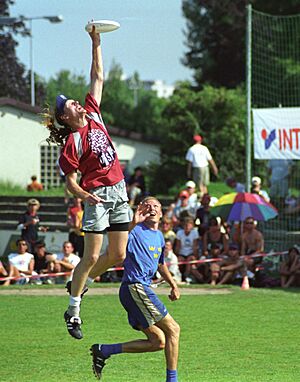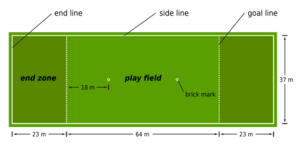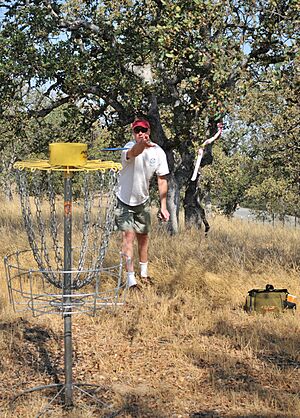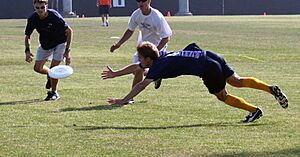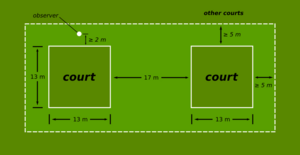Flying disc sports facts for kids
Flying disc sports are exciting sports and games played with special discs, often called Frisbees. Two of the most popular disc sports around the world are Ultimate and disc golf.
Contents
What is Ultimate?
Ultimate, sometimes called Ultimate Frisbee, is a fast-paced team game without contact. The main goal is to score points by passing the disc to a teammate in the other team's end zone. Players cannot run while holding the disc.
How to Play Ultimate
When you catch the disc, you can use one hand, both hands on the edge, or both hands on the top and bottom (like a clap-catch). If you catch with one hand, be careful to grab the side of the disc that spins into your hand for a secure catch. Many players prefer using both hands when they can.
Some popular throws in Ultimate include the backhand, sidearm (or forehand), hammer, and scoober. Players often practice freestyle throwing and catching to get better at handling the disc.
Ultimate was created in 1968 by Jared Kass as a fun evening game. A special part of Ultimate is its Spirit of the Game. This means players focus on fair play, good sportsmanship, and having fun. Organizations like USA Ultimate (USAU) and Ultimate Canada set the rules for Ultimate in the US and Canada.
There are also semi-professional leagues for Ultimate. The American Ultimate Disc League (AUDL) is a men's league. The Major League Ultimate (MLU) used to be a men's league but stopped playing in 2016. More recently, the Premier Ultimate League (2019) and the Western Ultimate league (2020) started as semi-pro leagues for women. The highest international competitions are the World Games and the World Ultimate and Guts Championship.
Other Games Like Ultimate
Many games are similar to Ultimate but have different rules. These are often played when there aren't enough players or a big enough field for a full Ultimate game.
| Game | Description |
|---|---|
| Goaltimate | A half-court disc game similar to Hot Box. |
| Hot box | A non-contact team sport like Ultimate, but played on a smaller field with fewer players. |
| Mini ultimate | A fast-paced game, often played in cities, on a smaller field than regular Ultimate. |
| D-Hoops | Also called Disc basketball, this game is played on a basketball court with specific rules. |
| Schtick disc | An Ultimate game played with two discs where players can run with the disc. It's often easier for players of different skill levels to enjoy. This game started in 1994 and has been played in the US and Australia. |
| Kan-jam | A disc game played with a disc and two cans. You score points by deflecting the disc into the can. |
Players often change the rules of Ultimate to fit the number of people playing, to make the game faster, or to practice certain strategies.
What is Disc Golf?
Disc golf is a game based on the rules of traditional golf. Instead of a ball and clubs, you use discs that are smaller and heavier than Ultimate discs. Players throw the discs towards a target, which acts as the "hole." Official targets are metal baskets with hanging chains to catch the discs.
Urban Disc Golf
Before there were special targets like pole holes, disc golf was played in parks and cities. Players would use natural objects like trees or lampposts as targets. Sometimes, players would even create their own courses as they played, deciding on targets and boundaries as they went along.
Freestyle Play and Competition
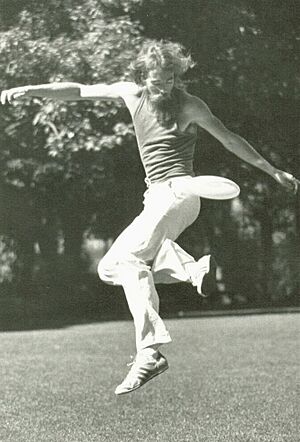
Disc freestyle, also known as freestyle Frisbee, is a sport and art form. It involves creative, acrobatic, and athletic moves with a flying disc. Freestyle can be done alone or, more commonly, in groups, both for fun and in competitions.
In the early 1970s, before a trick called the "nail-delay" was invented, freestyle catches were always spontaneous. Players would stand far apart and throw fast, varied discs. Catches were made right after the throw, sometimes with a kick or slap to keep the disc in play. At advanced levels, the throws and catches would flow together, looking like martial arts or dance.
Today, competitive freestyle often uses the nail-delay trick, where the disc spins on a fingernail. Many players use special tools like plastic nails or silicone sprays to help with this.
Many disc sport players use a simpler version of freestyle (without plastic nails or sprays) to warm up. Ultimate players, for example, find freestyle helps them improve their throwing and catching skills, and also helps with focus and flexibility.
Freestyle Competitions
In a freestyle competition, teams of two or three players perform a routine set to music. This routine includes many creative throwing and catching techniques. Judges score the routine based on how difficult the moves are, how well they are performed, and the overall presentation. The team with the highest score wins.
In 1974, Ken Westerfield and Jim Kenner (who founded Discraft) introduced and won the first flying disc freestyle competition. This happened at the 3rd annual Canadian Open Frisbee Championships in Toronto, Canada.
After this, other major disc tournaments, like the American Flying Disc Open and the World Frisbee Championships, added freestyle as an event. Today, freestyle is a popular event in disc tournaments worldwide. The Freestyle Players Association was created to manage competitive freestyle and help new players learn.
What is Guts?
Guts, or Guts Frisbee, is a disc sport inspired by dodgeball. Instead of balls, teams throw a flying disc at members of the opposing team. One to five players on a team stand in a line facing the other team across the court.
To start, teams "flip the disc" like a coin toss. One player from the starting team raises an arm to show they are ready to throw. The other team then freezes in place.
- If the thrower misses the "scoring area" (a marked space where the other team stands), the receiving team scores a point.
- If a player on the receiving team catches the disc cleanly, no one scores.
- If the throw is in the scoring area and the receiving team fails to catch it, or catches it but drops it, the throwing team gets a point.
The receiving team then picks up the disc and becomes the throwing team. Players on the receiving team must catch the disc cleanly with one hand. They cannot move until the disc leaves the thrower's hand. They also cannot trap the disc against their body or with their other hand. This often leads to exciting "tips" or "bobbles," where players hit the disc to slow it down and keep it in play until someone can catch it. This might involve several players on the receiving team.
The game continues until one team scores at least 21 points and has a lead of at least 2 points.
Double Disc Court (DDC)
Double Disc Court (DDC) was invented by Jim Palmeri. It's a sport played with two flying discs. Two teams, each with two players, stand in their own square courts. The goal is to protect your court from the other team's attacks.
The two identical square courts are 13 meters (about 42 feet) on each side. They are placed 17 meters (about 56 feet) apart on a flat grassy field.
Teams can score points in two ways:
- By throwing a disc into the opponent's court so it lands inside without touching out-of-bounds.
- By making both discs touch a player or players on the opposing team at the same time (this is called a "double").
A team also scores a point if an opponent throws a disc out-of-bounds. The first team to reach the agreed-upon number of points wins the game.
Canine Disc
Canine Disc, or dog disc, is a sport for dogs and their human partners. In competitions, dogs and their human disc throwers compete in events like distance catching and choreographed freestyle routines. This sport celebrates the special bond between a handler and their dog as they work together.
Disc Games Adapted from Other Sports
These games started when the rules of another sport were changed to use a flying disc instead of a ball.
| Game | Description |
|---|---|
| Guts and dodge disc | These are like dodgeball, but they use a flying disc instead of a ball. |
| Crosbee | Adapted from lacrosse, this game is a mix of touch football and Ultimate. |
| 500 | This game can also be played with a football or other ball. One player throws the disc to others and calls out a number between 0 and 500. The player who catches it earns that many points. The first player to reach 500 points becomes the new thrower. |
Other Fun Disc Games
- Flutterguts — A game mainly used to practice catching flying discs.
- Kan-jam - A game similar to horseshoes.
- Polish horseshoes - Similar to Fricket, but with a pole and a bottle on top at each end (also known as Beersbee).
- Friskee - A game with two 28-inch goals, two teams, and one frisbee.
|


